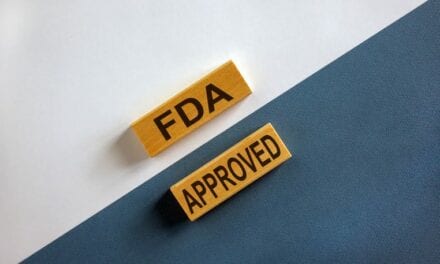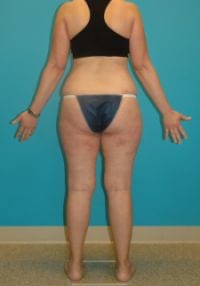
A female patient prior to body sculpting and laser lipolysis treatments.
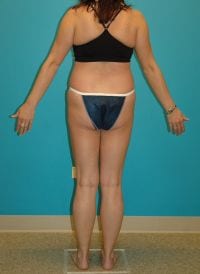
After body sculpting using the SmartLipo device to perform liposculpture of the back, hips, and thighs.
What is laser lipolysis exactly, and what is its role in new collagen formation?
The term “laser lipolysis” is a bit of a euphemism or misnomer in the sense that what it chiefly accomplishes is not lipolysis. Rather, it is shrinkage of tissue and the formation of new collagen.
It’s a very good technique. What it does—and what all lasers potentially do—is to distribute energy into living tissue, which then causes collagen production. With that in mind, the most important aspect to laser lipolysis procedures is the surgeon’s technique as the determining factor in successful outcomes.
Patients appreciate the results of laser lipolysis because it tends to produce smoother, tighter skin, as well as better adherence of skin to muscle, which advances our technology from where we were with laser-based devices in the 1990s, which was to resurface the outside of the skin. Now, we’re using lasers to stimulate collagen formation from within the skin.
WHERE WE’VE BEEN
As an idea, lipolysis’ focus was to break up fat cells, but it required a fluid- or water-based environment and suction. If you go back to 1987, when Jeffrey A. Klein, MD, published his original works on liposuction, we learned that when cells imbibe and are full of fluid, and suction is turned on, lipolysis occurs.
When you use laser energy both in terms of heat and its photo-acoustic effect, it does, of course, cause some lipolysis. Some studies have shown that if you perform only laser lipolysis and do not use suction, then you get almost no result. It is fairly certain that without suction and without a fluid environment, there is no true lipolysis and, therefore, any lipolysis that the laser adds is minimal.
On the other hand, several studies published over a 30-plus-year period—which were conducted by NASA and university departments all around the world—show that low-energy absorption in tissue does, in fact, cause both wound healing and collagen deposition. This is the true advantage of laser lipolysis: The skin is made smoother and heals with less morbidity and induration of the tissue. To us and to patients, it appears healing is faster because you don’t get as much swelling.
Ultimately, laser lipolysis has benefits that you can’t get from suction-assisted lipolysis alone. However, the success of laser lipolysis treatment has a lot to do with the surgeon and his or her knowledge of how to correctly perform the technique.
At a recent meeting of the Austrian Academy of Cosmetic Surgery, laser lipolysis was a big topic of discussion. It was a melding of many of the leaders in aesthetics in Europe and the United States, in which there was a huge amount of consensus on what laser lipolysis is and where it’s going.
At that meeting, I heard one statement with which I emphatically agree: “You must learn how to do surgery first, before you can adapt it to a machine.” In other words, a laser- or energy-based device is not going to do the surgery for you. That seems so obvious, but sometimes it needs to be stated.
The people I met at that meeting were very willing to show their bad results, which is terribly important when you’re looking at new technology. Most of the complications we looked at were related to poor technique and not related to the use of the instrument per se. The problem wasn’t the technology; the problem was the people who were using it did not understand the proper techniques.
The patient’s comfort is directly related to the surgeon’s quality. For my part, a large majority of patients do well during and after laser lipolysis procedures, and many of my colleagues across the country and in Europe have had the same experience. Without a doubt, practitioners are by and large advancing the technology in promising and successful ways.
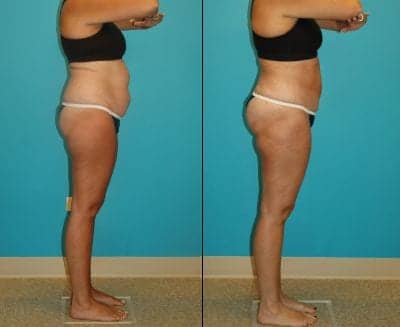
In this female patient, there was a significant amount of body sculpting of the abdomen, before (left) and after (right).
STUDIES IN MORBIDITY
I published two articles on morbidity and laser lipolysis treatments. The first was a retrospective study of 100 patients, half of whom had suction-assisted lipolysis alone and half of whom had laser lipolysis. Interestingly, immediately postoperatively after using techniques that were being advocated 5 or 6 years ago, patient discomfort, pain, bruising, and swelling were all worse with laser treatments.
Today, of course, those techniques have improved. The excessive pain and extended recovery times no longer occur if the physician understands that he has to modify the technique. For example, if one goes by what the laser companies originally proposed, which was to traverse to an arbitrary temperature, the surgeon will course through a lot of blood vessels. Only when you change your technique do you get less bruising.
Interesting enough, in spite of morbidity, 3 months later patients overwhelmingly preferred laser lipolysis to the suction-assisted kind. The reason? They liked the results better. Despite any discomfort or problems we caused, they perceived a reward at the end of the tunnel.
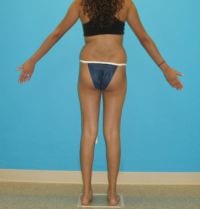
This female patient with scoliosis desired a slimming of the hips.
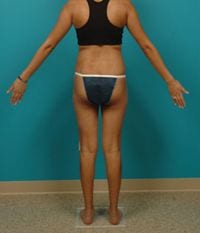
The solution was sculpting of the hips using the SmarLipo for liposculpture treatments.
In the other study, I offered three case reports of extensive ecchymosis, which contradicts the claim that laser lipolysis causes coagulation of blood vessels. Again, if a surgeon takes a wand that’s 1 millimeter or less in diameter and passes it a thousand times through the skin, then many blood vessels have been burned open and are still bleeding. This is only a problem when outmoded laser techniques are used—that is, moderately high energy repeatedly traversing the subcutaneous tissue will rupture a large number of blood vessels.
In my judgment—and that of the majority of people at the Austrian meeting—when you put too much energy in tissue, and this is one of the dangers with these new lasers that are getting hotter and hotter, you’re going to see an increase in morbidity and you are going to damage more patients.
In the 1990s, we had what I thought was a very good tool in ultrasonic-assisted liposuction. However, the manufacturers made the machines too powerful and too many practitioners were not adequately trained in how to use them. As a result, many patients suffered so many burns and serious complications that the industry had to abandon what could have been a good technology. If laser-based devices are used in the same way, the exact same thing is likely to happen.
THE DETERMINING FACTORS
My concept of laser lipolysis—and this is true in all energy-based applications in living tissue—is one of low energy absorption. There are plenty of examples in nature of the physiological effects of low energy absorption. Photosynthesis is the best one, but one can also point to numerous physiology studies that have existed in the scientific literature for decades.
Mary Dyson, PhD, FCSP, emeritus professor of physiology at King’s College, London, conducted studies using lasers at various wavelengths. She was able to show, regardless of the energy type that she applied to the tissue, with low energy settings she could get collagen remodeling. What we have to do for the future is to learn how to adapt low-level energy using these same lasers—to reduce the energy to get maximal skin improvement.
When I turn on the suction in a fluid environment, I always know I’m going to get lipolysis. I don’t need the boost of laser energy. What I do need is something that will remodel tissue and produce better collagen production, as well as better adherence of the skin.
The goal is to have the least amount of morbidity, the best results, and the best skin rejuvenation. Ultimately, that is why laser lipolysis has taken over in the aesthetic field. These devices are being supplemented with new technology in ultrasound and radio frequency because we now have a technique to enhance skin results and achieve skin improvement, in addition to the body contour improvement. That is what the new laser technology brings to the table.
Edward Lack, MD, is a former president of the American Academy of Cosmetic Surgery and has served as acting chairman of oral examinations for the American Board of Cosmetic Surgery. He has lectured around the world, including a presentation at the 11th Annual Austrian Academy of Cosmetic Surgery. He is in private practice in Chicago and can be reached at (847) 832-6700.






